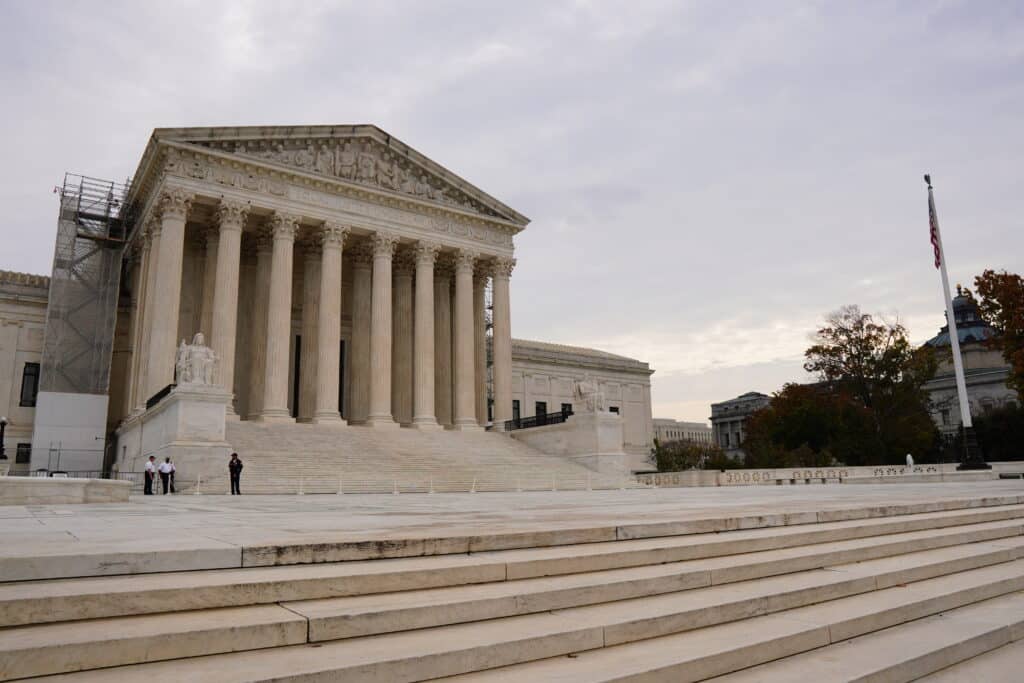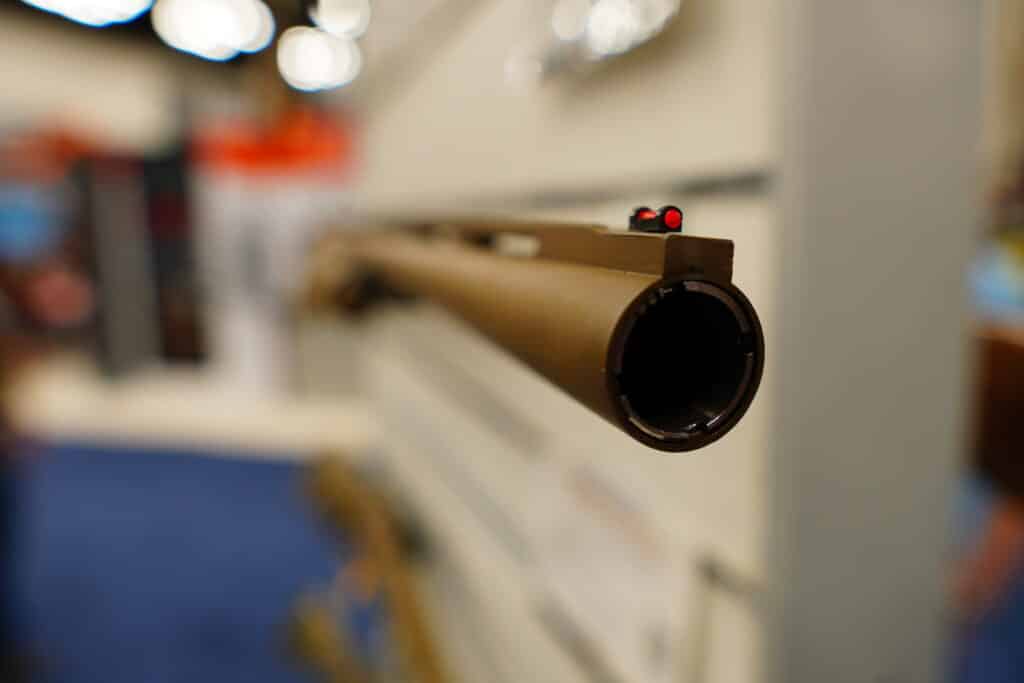The Department of Justice wants the Supreme Court to take up the case against its “ghost gun” ban. Contributing Writer Jake Fogleman explains why the Court is very likely to take action in the case.
I was at former President Donald Trump’s speech at the NRA’s Great American Outdoor Show. Some of the drama was taken out by the surprising fact that the NRA didn’t formally endorse him during the event, even though it went right up to that line. Trump made a lot of promises to gun-rights activists, but his performance also contrasted in interesting ways with his 2016 stump speeches.
I also take a look at some of the takeaways from the surprising conviction of Jennifer Crumbley for her son’s school shooting. Is this just a one-off situation? Or will the consequences of this verdict be much more widespread?
Plus, a non-profit law professor weighs in on where the NRA’s corruption trial is headed as it nears a close.

Analysis: SCOTUS Has to Speak on ATF ‘Ghost Gun’ Case [Member Exclusive]
By Jake Fogleman
The Biden Administration wants the High Court to weigh in on another gun-related case. The Court will almost certainly do so.
On Wednesday, the Department of Justice (DOJ) petitioned the Supreme Court to hear VanDerStok v. Garland. The agency’s request followed a November 2023 Fifth Circuit Court of Appeals decision that found the ATF’s ban on unfinished gun parts and kits “unlawful.” The DOJ disagreed with that outcome and requested that the nine justices reverse the Fifth Circuit.
Unlike the vast majority of cert petitions, this one stands an unusually high chance of being granted in some form or fashion for several reasons. First and foremost is who filed the request in this case.
The Supreme Court generally places greater weight on petitions filed by the federal government as a matter of practice. That’s because agencies like the DOJ typically only file cert requests with the justices when there’s an open discrepancy in the law due to lower court decisions that have created practical concerns with federal rules not being applied everywhere. When the DOJ says a legal matter desperately needs clarification, the High Court tends to listen.
The Court’s current term is a perfect example of this tendency in practice. The justices have already agreed to hear two separate gun-related cases following requests from the DOJ this session alone—US v. Rahimi and Garland v. Cargill—with several others under active consideration.
The ATF “ghost gun” ban case also has an unusual procedural history, making it a likely candidate for review.
The district court judge overseeing the case issued multiple injunctions against the ATF’s rule last year after finding that the agency had overstepped its authority in attempting to regulate unfinished gun parts and kits like functioning firearms. The Fifth Circuit affirmed those rulings. It subsequently declined to issue a stay on those rulings.
Despite those successive outcomes, the Supreme Court twice granted the DOJ’s motion for an emergency stay on any order prohibiting it from enforcing the rule. In both instances, the Court noted that it was intervening to allow the regulations to remain in effect while the appeals process played out at each level of the federal judiciary.
Not only did those twice granted emergency stays indicate that the Justices have been keeping an attentive eye on this case, but the terms of those stays also set a timer that, when paired with the Fifth Circuit’s ruling on the merits, make further Supreme Court guidance almost inevitable.
More specifically, because the stays on the orders striking down the ATF’s rule are set to expire pending the “disposition of a petition for a writ of certiorari,” that means that the Fifth Circuit’s decision against the ATF’s rule would immediately take effect if the Supreme Court rejects DOJ’s request. Such an outcome would blow a hole in the federal government’s firearms regulations. It could also risk split outcomes on the question of ATF’s authority in separate circuits currently considering similar litigation.
Those are precisely the scenarios kind the Supreme Court generally tries to avoid when possible, which just leaves the question of which form the Supreme Court’s response will take.
The Court has already agreed to hear a case dealing with the ATF’s legal authority to reverse its long-standing positions and reinterpret how to enforce federal firearms law in Cargill later this month. Cargill deals with the ATF’s attempt, at the behest of former President Donald Trump, to reclassify bump stocks as “machineguns” under federal law–effectively outlawing their possession in the process.
Since the bump stock ban is so similar to the ghost gun ban, the Court could hold DOJ’s VanDerStock petition until it issues a decision in Cargill. Depending on the outcome it ultimately reaches in that case, it could either grant, vacate, and remand the VanDerStock case back down to the lower courts to be reheard in light of its new Cargill guidance or otherwise take up VanDerStock with Cargill fresh on its mind.
Alternatively, the Court could grant DOJ’s petition independently of its other gun-related administrative law case. That’s less likely but not entirely out of the question given the Court’s posture against legal deference to administrative agencies.
In recent terms, the Court has cracked down on the ability of executive agencies like the Environmental Protection Agency and the Department of Education to reinterpret long-standing federal statutes and enact novel policies. In the current term, the Court is considering a case aimed at whether agencies should continue to enjoy broad deference in their interpretations of ambiguous statutes passed by Congress.
Taken together, these actions suggest a Court ready and willing to cast a skeptical eye toward unilateral executive lawmaking.
Whether that streak extends to the ATF’s latest positions on federal firearms law remains to be seen, of course. But no matter which way the Court is ready to rule on the questions surrounding the ATF’s authority, it will almost certainly be issuing an order on more than just bump stocks in the near future. Ghost guns will probably get the same treatment.

Trump Makes Promises to NRA Faithful
By Stephen Gutowski
Harrisburg, Pennsylvania — Former President Donald Trump made a series of gun policy promises in a speech to NRA members that ranged from raucous to repetitious.
Speaking before a crowd of thousands that nearly filled up the New Holland Arena at the Great American Outdoor Show, though there wasn’t a vast overflow crowd as he claimed, Trump recounted his record on gun policy–most of it accurate. He also previewed what he planned to do on gun policy with another term in office. Most of those plans revolved around undoing President Joe Biden’s efforts to institute new gun restrictions.
“Every single Biden attack on gun owners and manufacturers will be terminated my very first week back in office,” Trump told the crowd to cheers.
The event ended somewhat anti-climactic. Despite creating a new political event, the Presidential Forum, for the Great American Outdoor Show and doing everything but, the NRA did not issue a formal endorsement of Trump (though Trump said it better do so when he speaks to the group again at its Annual Meeting in May). And, while he made specific promises to undo Biden’s gun efforts and sign a national concealed carry reciprocity bill, those were all points he’d made at previous NRA events.
But the event did give Trump the opportunity to stump in the key swing state of Pennsylvania. His win there in 2016 helped propel him to a surprise victory, and his loss in 2020 (though he lied about winning the state that year in his speech) kept him from repeating. The outcome of the 2024 race in Pennsylvania will likely be decisive in what’s shaping up to be a rematch between Trump and Biden.
Trump sought to draw a stark contrast between himself and Biden on gun policy during the speech.
“Joe Biden and his thugs will do everything in their power to confiscate your guns and annihilate your God-given right to self-defense,” he said. “A meaningful Second Amendment, which you have, it’s under siege. They got nowhere with me, but there are a lot of other things happening with Biden.”
However, despite doubling down on his support for it early in the primary campaign, Trump did not mention his unilateral bump stock ban and confiscation effort. That ban has served as a template for many of Biden’s executive rulemaking on guns. It has also been declared unconstitutional by the Fifth Circuit Court of Appeals, and the Supreme Court is set to hear a case against it this term.
Trump touted a number of genuine accomplishments on guns during his speech. He pointed to his signing of a bill to repeal an Obama-era regulation that would have barred some Social Security recipients from owning guns–his only legislative win on firearms. Trump pointed to his action declaring gun stores essential businesses during the pandemic as well. But he also claimed to have reversed what seems to be an imagined ammunition ban.
Trump and the NRA have enjoyed a very close relationship since the gun group became the first major organization to endorse the former president before the end of the contentious 2016 Republican primary. It was one of the only ones to spend big, putting more than $50 million into the race during his surprise victory over Hillary Clinton. Trump rewarded that effort by often giving the NRA his ear when he was in the Oval Office.
The relationship didn’t always go swimmingly, with the NRA having to talk Trump out of supporting gun-control measures like “red flag” laws and “assault weapons” bans in the wake of several mass shootings. But that influence did manage to keep Trump from going all in on pursuing those policies.
As Trump touted in his Friday speech, the relationship also culminated in the appointment of three Supreme Court justices who all signed on to the majority in NRA-affiliate New York State Rifle and Pistol Association’s landmark victory over the state’s restrictive gun-carry permitting regime.
But the Outdoor Show speech comes as both Trump and the NRA have become bogged down in serious legal fights. Trump is fighting 91 felony indictments stemming from his attempt to overturn his 2020 election loss and refusal to turn over classified documents after leaving office–indictments that make it illegal for him to buy new guns. The NRA is facing a corruption trial over its leadership, including recently-resigned CEO Wayne LaPierre, diverting millions of NRA dollars to lavish personal expenses, such as private flights and luxury vacations.
The outcome of those cases could radically alter the trajectory of the Trump campaign or the entire makeup of the NRA. But, wherever things end up, the legal battles have already taken a severe toll on the spending ability of both.
Trump’s political operation spent much of the money it raised in 2023 on fighting his charges and numerous lawsuits that extend beyond the criminal cases. The NRA is in a similar spot, having spent more than $100 million on outside lawyers over the past five years. It’s unclear how many members the group has left, but it’s down far more than a million from before the corruption allegations surfaced. Its election war chest is lagging well behind previous cycles.
But Trump and the NRA remain potentially potent political forces.
Turnout for the Great American Outdoor Show likely made it one of the top gun shows in the world once again, even if the crowd wasn’t quite at capacity and parking was still easy to get in the late afternoon. Trump was still able to inspire laughter, adoration, and derision (directed alongside shouted profanity at those in the media pen) from his supporters–at least, at certain points.
There’s also a clear opening to run against President Biden on gun policy. Biden has signed the first new federal legislative restrictions on who can own a gun in a long time and implemented multiple administrative bans on popular firearms and accessories. He’s called for doing even more, such as banning AR-15s and ammunition magazines. But those efforts haven’t helped improve his poor approval rating on gun policy.
Biden and Trump–each deeply unpopular–have run mostly within the margin of error to this point in 2024 polling. Still, Trump is currently up less than two points in the Real Clear Politics average of polls.
“I can tell you that the only thing standing between you and the obliteration of your under-siege Second Amendment is me,” Trump said to riotous cheering as he hit on a crowd-pleasing line while meandered through his stream-of-consciousness speech.
But, as his speech crossed the hour mark, few Trump supporters were left standing or yelling. Trump’s tendency to repeat topics and go on extended asides seemed to wear on their enthusiasm after a while. By the end, 15 minutes later, about half of the arena had already cleared out.
Podcast: Non-Profit Law Professor James Fishman on the NRA’s Corruption Trial [Member Early Access]
By Stephen Gutowski
This week, we’re looking ahead to the end of the NRA’s corruption trial that’s set to arrive on Friday.
To better understand exactly what’s at stake in the case, I’ve brought on an expert in not just non-profit law but New York non-profit law. Pace University Law Professor James Fishman, who has written extensively on the subject, joins the show to give us some expert insight into the facts of the case and the potential outcomes. He provides an overview of what to expect once the case ends.
Fishman argued the admitted misappropriation of funds by current and former NRA leadership, especially former CEO Wayne LaPierre, put the group in serious legal jeopardy. He also dismissed many of the arguments the group and its leadership have used in the case thus far.
He painted a dim picture of the group’s chances for success in the case.
Fishman did admit New York Attorney General Letitia James (D.) erred when describing the NRA as a “terrorist organization” during her campaign. But he explained the NRA’s repeated attempts to use her comments as a defense in the case failed because the AG built her case around provable instances of corruption and misappropriation of funds that have left the NRA in dire straights. He argued those facts would weigh more on the judge and jury than the AG’s rhetoric.
As for the likely outcome, Fishman said the NRA will likely end up with a court-appointed overseer in charge of vetting its financial decisions. He said the overseer could also force reform on the group’s 76-member board and its opaque bylaws.
Plus, Contributing Writer Jake Fogleman and I discuss the Hawaiian Supreme Court ruling putting the “Spirit of Aloha” above gun rights.
You can find the show on your favorite podcasting app or by clicking here. Video of the episode is available on our YouTube channel. Reload Members get access on Sunday, as always. The show goes public on Monday.

Analysis: The Implications of the Jennifer Crumbley Conviction [Member Exclusive]
By Stephen Gutowski
This week saw a potential landmark ruling holding a parent responsible for a mass shooting carried out by their child.
Jennifer Crumbley, whose son murdered four fellow students at his Michigan high school in May 2021, was found guilty of involuntary manslaughter on Tuesday. The jury held her responsible for the killings not because she actively planned or participated in them but because she didn’t do enough to stop them. The decision represents the first time a jury has held a parent responsible for a school shooting they weren’t actively involved in.
It raises a host of questions for gun owners and parents across the country.
The most immediate: is the verdict the product of the uniquely egregious facts of this case, or does it speak to a larger emerging trend?
Anyone who watched the trial knows that Mrs. Crumbley did not make for an especially sympathetic defendant. With Americans, and likely many jurors, exhausted by the frequency of school shootings, she did little to express contrition or regret. She even testified she wouldn’t have done things differently in retrospect–a bizarre thing to say after your child murders four other children.
The facts of what happened in the lead-up to the shooting didn’t help make her more sympathetic either. Her son displayed signs of severe mental health issues, including texts to her about seeing ghosts that went unanswered. But she didn’t get him mental health treatment.
When the school called in her and her husband because their son drew disturbing images and wrote concerning messages on a worksheet indicating he was a danger to himself or others, they decided not to take him to receive immediate help because they didn’t want to miss work. Instead, they sent him back to class. Incredibly, Jennifer Crumbley described that fateful meeting as “nonchalant.”
Later that same day, he took a handgun out of his bag and used it to shoot his classmates.
And, of course, that handgun was one she and her husband bought for him. The foreman of the jury said the idea Jennifer was the last one to handle the gun before her son took it was a significant factor in their decision. It’s still unclear exactly how he got that gun. But her testimony that she didn’t feel she was responsible for the gun because that was her husband’s role likely didn’t help her either.
Would the jury have convicted her of criminal negligence if all those factors weren’t present at once (especially the egregious inaction during the meeting shortly before the shooting)? Or does this mean that juries will now hold parents liable for violence committed by their children if only one of those factors is present?
Should parents be held liable for their child carrying out a shooting purely if they do it with a gun that wasn’t properly secured? And what level of security would be necessary in a scenario like that? Jennifer Crumbley testified that they did take steps to lock up their various guns, including the one they bought for their son to use with them at the range.
She didn’t seem to know the full details and felt she shouldn’t be responsible for them because she viewed it as her husband’s role, which is probably a fairly common view for a lot of gun-owning households. It’s a wrongheaded view since adults ought to be responsible for the guns in their homes, but it’s probably not rare.
It’s important to note that there’s a world of difference between securing a gun from a small, curious child and a determined teenager. Jennifer Crumbley alluded to the possibility that her son knew where they stored the key to the handgun’s lock, which indicates they weren’t very diligent in their security efforts.
But what happens if somebody is diligent and their child manages to get ahold of their gun anyway? Will they be held to the same standard? Where does that line fall?
What about the mental health side of the equation? Jennifer Crumbley said she didn’t think the red flags brought up in retrospect were significant at the time. She said the disturbing messages brought to her attention shortly before the shooting weren’t pressing enough to take immediate action, which the school officials apparently agreed with.
Maybe the signs in the Crumbley’s case were so evident that it was negligent not to follow through on them with treatment. What happens if the signs are a bit less conspicuous? Can parents be held responsible for not getting their children the right treatment at exactly the right time? Where is that line?
This case could inspire lawmakers to try to draw those lines more definitively through things like gun storage laws. But, given the politicized nature of the gun debate, especially at the state level, that’s unlikely to happen outside of blue states. And even there, it could be difficult since storage laws tend to be controversial for taking a one-size-fits-all approach that deprioritizes the use of guns for self-defense–the top reason most Americans own guns in the first place.
The more common way we’ll likely see these lines tested in the wake of Jennifer Crumbley’s conviction is through prosecutors pursuing similar charges. The outcome in this case will probably embolden prosecutors to go after parents of other mass shooters and lower-profile killers.
The first test of how broad the implications of the verdict against Jennifer will come in the form of the case against her husband, James Crumbley. That trial is scheduled to begin in March. How it goes may determine how much more frequent these sorts of cases become.
That’s it for now.
I’ll talk to you all again soon.
Thanks,
Stephen Gutowski
Founder
The Reload






